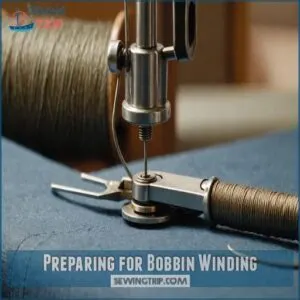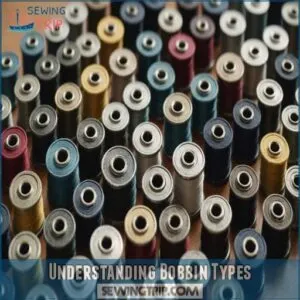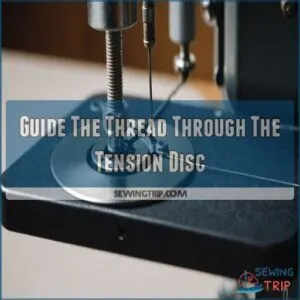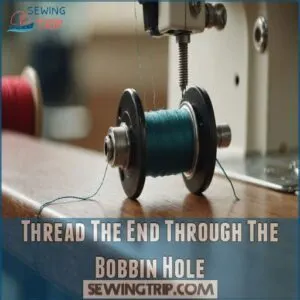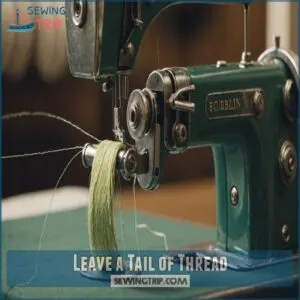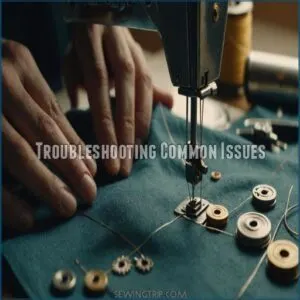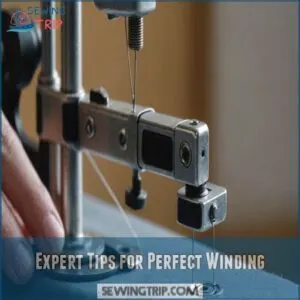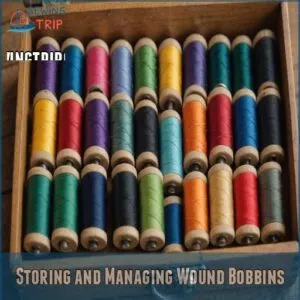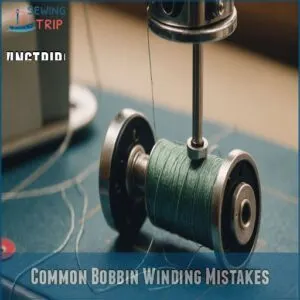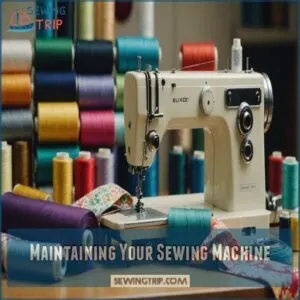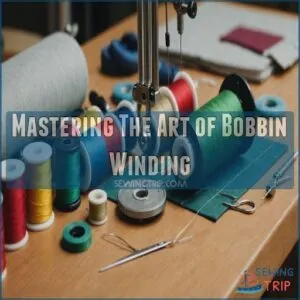This site is supported by our readers. We may earn a commission, at no cost to you, if you purchase through links.
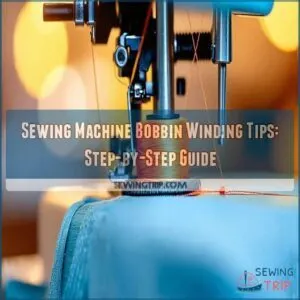
First, gather your materials and choose a thread that matches your fabric.
Inspect and clean your bobbin—trust me, a dusty bobbin is nobody’s friend.
Thread the bobbin by guiding the thread through the tension disc, leaving a decent tail to hold.
Make sure your bobbin winder is locked before hitting the pedal.
Monitor the winding process like a hawk to ensure even tension.
Feeling a bit tangled? Check your tension settings.
Stay tuned for tips on mastering metallic threads and preventing those pesky tangles!
Table Of Contents
- Key Takeaways
- Preparing for Bobbin Winding
- Understanding Bobbin Types
- Threading The Bobbin
- Winding The Bobbin
- Troubleshooting Common Issues
- Expert Tips for Perfect Winding
- Storing and Managing Wound Bobbins
- Common Bobbin Winding Mistakes
- Maintaining Your Sewing Machine
- Mastering The Art of Bobbin Winding
- Frequently Asked Questions (FAQs)
- Conclusion
Key Takeaways
- Gather all your materials, like thread and scissors, before starting to ensure a smooth bobbin winding process without interruptions.
- Inspect and clean your bobbin and bobbin case regularly to prevent dust and lint buildup, which affects thread tension and sewing quality.
- Use the correct thread type for your fabric and ensure proper tension to avoid tangling and ensure smooth stitch quality.
- Consult your sewing machine manual for diagrams and troubleshooting tips on proper bobbin threading techniques, such as threading a Singer bobbin, to avoid common bobbin winding mistakes and improve your technique.
Preparing for Bobbin Winding
Before you get started with winding your bobbin, make sure you’ve gathered all the essentials, like thread and scissors—no one likes scrambling for tools halfway through!
A quick peek at your sewing machine’s manual will also save you from any "oops" moments later on.
Gather Necessary Materials
Ready to start bobbin winding?
First, grab your essentials: a sewing machine, bobbins, and scissors.
Don’t forget a small brush for cleaning any dust bunnies lurking in the bobbin case.
Check your bobbins and storage containers for wear.
It’s all about preparation, so keep your tools organized and avoid the—you guessed it—“where did I leave that?” moments!
Choose The Right Thread
Choosing the right thread is like picking the perfect ingredient for your favorite dish.
Consider thread weight and type for your fabric, ensuring quality to avoid tangles.
Match the thread color to your material, thinking about bobbin tension.
Remember, the thread’s purpose dictates the choice, like threading through a maze of possibilities but emerging victorious with perfect stitches!
Inspect and Clean The Bobbin
Before diving into bobbin winding, take a moment to inspect and clean your bobbin and the bobbin case. It’s important for smooth sewing adventures. Regularly cleaning the bobbin case, ideally every 1-3 months, will also help keep thread tension just right. – Check the bobbin condition for cracks or damage. – Use cleaning tools like a small brush to remove lint. – Examine wear signs in the bobbin case to keep thread tension just right.
Consult The Sewing Machine Manual
After tidying up the bobbin, grab that sewing machine manual like it’s your roadmap.
It’s packed with nifty winding diagrams and maintenance tips that’ll keep your machine humming along nicely.
Wondering about bobbin types or bobbin case compatibility? It’s all in there.
Think of it as a troubleshooting guide for successful bobbin winding adventures!
Understanding Bobbin Types
Before you start winding, you’ll want to understand the different bobbin types.
Knowing your machine’s specific bobbin needs prevents frustrating jams and guarantees perfectly even stitches—because nobody wants a wonky project!
Different Bobbin Sizes
You’ve gathered your materials; now let’s talk bobbin sizes—because they’re not one-size-fits-all!
Bobbin compatibility is key for happy stitching.
Size comparison matters since common sizes vary across machines.
Matching bobbins to your machine avoids threading mishaps.
So when you’re choosing the right size, consider bobbin winding and thread tension to keep everything purring like a well-oiled sewing machine.
Bobbin Materials and Quality
Bobbin materials can make all the difference in your sewing journey. Here’s the scoop:
- Plastic bobbins are lightweight and budget-friendly but wear out faster.
- Metal ones boast durability and steadier bobbin thread tension.
- Aluminum offers a sweet spot between weight and strength.
- Choosing quality impacts bobbin lifespan, stitch consistency, and overall sewing success.
Keep these in mind as you whirl through your projects!
Choosing The Right Bobbin for Your Machine
Before picking a bobbin, think about its compatibility with your machine.
You wouldn’t want to jam things up with the wrong size or material!
Not all bobbins are created equal.
Here’s a quick guide:
| Bobbin Type | Use With |
|---|---|
| Metal bobbin | Heavy-duty sewing |
| Plastic bobbin | Basic sewing projects |
| Class 15 bobbin | Older, vintage models |
| L bobbin | Industrial machines |
Choose wisely and happy sewing!
Threading The Bobbin
Threading the bobbin might seem as tricky as threading a needle, but once you get the hang of it, you’ll be breezing through projects.
Start by guiding the thread through the tension disc, threading it through the bobbin hole, and leaving a small tail—like coaxing a shy cat out of a cozy corner.
Guide The Thread Through The Tension Disc
Think threading your sewing machine’s tension disc is tricky. Mastering the bobbin winding process, like learning to thread a mini sewing machine, is just as important for a smooth sewing experience? Don’t worry!
Just feed your thread smoothly through the tension disc, ensuring it’s snug but not too tight.
Variations in the thread path can occur, so adjust as needed, aiming for consistent tension.
This small step keeps your bobbin winding smooth and avoids thread snarls, which we all love to hate!
Thread The End Through The Bobbin Hole
Getting that thread through the bobbin hole can feel like threading a needle’s cousin! Pinch the thread end and guide it through the bobbin hole, making sure it’s snug. This technique isn’t just about precision; it makes sure the thread flows smoothly without tangles.
- Consider bobbin hole sizes
- Locate perfect bobbin hole placement
- Explore different threading techniques
- Understand thread types
- Avoid bobbin hole issues
Leave a Tail of Thread
A four-inch thread tail is your secret weapon!
It helps prevent those annoying tangles during bobbin winding.
Seriously, it’s a game-changer.
This little tail, whatever your thread type, helps secure the thread to the bobbin.
A properly secured tail helps create even bobbin tension, preventing frustrating breaks.
Don’t underestimate its power in preventing those frustrating sewing machine bobbin tension issues.
Trust me, this simple step will make your bobbin winding a breeze!
Winding The Bobbin
To wind the bobbin, you’ll want to engage the bobbin winder and keep a close eye on the process.
Don’t forget to adjust the tension so your thread winds smoothly without any hiccups.
Engage The Bobbin Winder
Pop that bobbin onto the winder spindle with confidence!
Slide the winder mechanism to engage it, usually with a satisfying click.
Feel the thrill as the bobbin winder hums to life.
Don’t forget, each sewing machine might’ve its own quirks.
If it doesn’t spin, some troubleshooting tips might be needed to adjust the winder tension.
Monitor The Winding Process
Once the bobbin winder is engaged, keep your eyes peeled on the winding process, and pay attention to the thread tension, as proper bobbin winding techniques can greatly impact the quality of your stitches.
Listen for any unusual noise—a sign something might be amiss.
Make sure the bobbin fills evenly, watching the thread path.
If uneven bobbin filling or slack thread appears, pause and regroup.
Remember, steady winding speed contributes to flawless sewing machine care and effortless projects!
Adjust The Tension as Needed
When winding the bobbin, keep an eye on that tension screw.
Adjust as needed for your thread type and fabric weight, ensuring seamless stitch quality.
Different bobbin sizes might require tweaks, so don’t shy away from experimenting.
It’s like seasoning your soup—just a little change can make everything perfect.
Embrace these sewing tips and enhance your sewing machine experience!
Troubleshooting Common Issues
Sometimes, winding a bobbin feels like taming a wild beast, with threads tangling or breaking, and tensions going haywire.
But don’t worry, tackling these common hiccups can be easier than you think with a few quick fixes.
Uneven or Loose Winding
You’ve carefully engaged your bobbin winder, yet something’s off.
Uneven or loose winding in your sewing machine can be a real hassle.
Consider these steps to tackle it:
- Check bobbin tension issues
- Monitor thread type impact
- Adjust winding speed control
- Ensure proper bobbin winder calibration
Remember, even your machine’s age can cause quirks!
Thread Tangling or Breaking
So, your bobbin’s a tangled mess? That’s frustrating!
Check your thread quality; old thread often breaks.
Make sure the thread path is clear—a tiny snag can cause big problems.
Is your bobbin tension too tight? Loosen it a bit.
Remember, a smooth, even winding speed is key.
Sometimes, it’s just a matter of finding the right rhythm.
Keep practicing, and you’ll be a bobbin-winding pro in no time!
Bobbin Winder Engagement Problems
Thread tangles got you wound up?
Let’s tackle bobbin winder engagement problems next!
Check if a disengaged handwheel‘s causing the hiccup.
Feel like a detective by hunting for obstructions or model-specific quirks fiddling with the winder mechanism.
A quick troubleshooting guide will help you sleuth your sewing machine repair needs.
Focus on the bobbin winder shaft for smooth winding!
Expert Tips for Perfect Winding
You might think winding a bobbin is as straightforward as threading a needle, but a few expert tricks can save you from a tangled mess.
From holding the thread just right to handling those pesky metallic threads without turning your sewing room into a glitter bomb, these tips will elevate your sewing game.
Controlling Tension With Your Hands
Ever tried balancing a bobbin like a tiny circus act?
It all boils down to finger pressure and hand tension, which is important in preventing thread breakage and tangling, as explained in mastering thread tension adjustments.
As the thread dances onto the bobbin, gently pinch it to control thread tension.
This simple move helps smooth bobbin winding, boosting sewing efficiency.
It’s like a sewing handshake—firm, but friendly—guaranteeing seamless stitches every time.
Winding Metallic Threads
Just like taming a wild horse, managing metallic thread requires finesse.
Keep your bobbin winding speed slow to prevent thread breakage mid-gallop.
Adjust the bobbin winder so the metallic threads don’t snag or tangle.
Consider a bit of thread lubrication for smoother winding.
Once mastered, your sewing machine will be purring like a contented cat!
Winding Elastic Threads
Switching gears from metallic threads to elastic ones? You’ll need patience and precision. Loosen your grip a bit, and remember these key tips for winding: To get the perfect wind, consider investing in a specialized tool, like an elastic bobbin winder. – Elastic thread tension: Wind 10% looser to avoid snapping.
- Bobbin winding speed: Slow and steady wins the race.
- Bobbin storage: Keep away from heat to maintain elasticity.
Enjoy your sewing adventure!
Storing and Managing Wound Bobbins
You’ve got your bobbins perfectly wound, but now what? Keeping them organized in a cool, dry place and winding several at once can save you headaches down the road.
Store in a Cool, Dry Place
Proper bobbin storage is key to thread longevity!
Keep those perfectly wound bobbins in a cool, dry place.
Humidity’s a bobbin’s worst enemy, causing thread to weaken.
Use airtight containers for extra protection.
Think of it as a spa day for your sewing supplies – they’ll thank you!
Following these simple bobbin storage tips helps your sewing machine run smoothly.
Happy sewing!
Wind Multiple Bobbins at Once
Imagine this: you’re in the zone, sewing a masterpiece, when suddenly, you run out of bobbin thread.
Avoid disrupting your flow by winding multiple bobbins at once.
It’s a real game-changer!
Utilize time-saving techniques and bulk bobbin storage to keep everything organized.
This efficient bobbin winding will keep your sewing machine purring smoothly, one project after another.
Use a Bobbin Winder Attachment
Feeling creative after winding a batch of bobbins? Consider using a bobbin winder attachment to boost your sewing productivity.
These nifty gadgets come with different bobbin winder types and speeds, compatible with most machines.
Regular winder maintenance keeps winding quality excellent.
Learning the basics of sewing machine setup through sewing machine tutorials for beginners, such as understanding the threading path and spool pin location is key to mastering your machine. You’ll find winding bobbins a breeze, perfect for diving into sewing machine tutorials for beginners.
Common Bobbin Winding Mistakes
You know how frustrating it can be when bobbin winding doesn’t go as planned, right?
Let’s tackle some common mistakes together, like using the wrong thread or incorrect tension when sewing buttonholes, which can be avoided by learning techniques from guides on sewing perfect buttonholes tips, and forgetting to trim that pesky excess thread, so your sewing projects come out flawless every time.
Using The Wrong Thread
Sometimes, picking the wrong thread is like trying to fit a square peg in a round hole.
Incompatible thread messes with bobbin tension, leading to poor stitch quality or even sewing machine damage.
For your sewing machine projects, selecting the right bobbin size, such as the common Class 15 bobbins, is crucial for smooth operation. Always check your sewing machine user manual to make sure thread compatibility is correct.
When using a Singer sewing machine with a unique bobbin design Singer bobbin mechanism, it’s essential to understand how the bobbin works to achieve proper thread tension. Avoid thread breakage by matching your thread to your bobbin winder and sewing machine patterns.
Incorrect Tension
Incorrect tension in your bobbin winding can feel like juggling water balloons—messy and unpredictable.
Tension problems might lead to bobbin tightness, thread slipping, and those annoying loose stitches.
Make sure your bobbin winder is set up correctly and experiment with different tensions until your sewing machine operation is smoother than a rollercoaster ride.
Happy sewing projects await!
Not Trimming Excess Thread
Don’t let excess thread wreak havoc on your sewing adventures.
Regularly cleaning dust and lint from the bobbin area using a soft brush or compressed air, as explained in Singer Bobbin Winding Solutions, can also help prevent jams.
Snip those rogue tails before they cause:
- Bobbin thread tangles – Nobody wants a mess.
- Sewing machine jams – A surefire creativity killer.
- Stitch quality issues – Keep your projects looking sharp.
So grab those scissors, embrace a clean start, and let your creativity flow without a hitch!
Maintaining Your Sewing Machine
Keeping your sewing machine happy is key to smooth sailing!
Regularly clean the bobbin area, check for wear and tear, and follow your machine’s maintenance schedule – your machine will thank you with perfectly sewn seams.
Regularly Clean The Bobbin Area
Mistakes behind us, let’s tackle another biggie: keeping your bobbin area spotless, which is a vital part of the overall sewing machine cleaning guide.
Regular Bobbin Case Cleaning keeps sewing smooth and hiccup-free.
Grab proper tools, like a small brush for Lint Removal.
Set a Cleaning Schedule to Prevent Jams and extend your bobbin winder’s life.
Your sewing machine will thank you for the TLC—no kidding!
Check for Wear and Tear
Once you’ve tidied up the bobbin area, it’s time to check for wear and tear.
Keep your eyes peeled for:
- Bobbin case wear: A worn case can mess with tension, so consider checking out Bobbin case tension solutions.
- Needle damage: A bent needle spells trouble.
- Tension issues: Poor tension leads to sloppy stitching.
- Bobbin winder wear: Check if it’s worn out.
Spotting early saves hassle!
Follow The Machine’s Maintenance Schedule
Keeping your sewing machine in top shape isn’t just about checking for wear and tear; following the maintenance schedule is key.
Regular care keeps your stitches smooth and machine purring.
Dust off that manual, and discover cleaning tips, the lubrication schedule, and easy troubleshooting guides.
Remember, just like you need vitamins, your machine thrives on regular check-ups!
Mastering The Art of Bobbin Winding
Mastering bobbin winding is like learning to ride a bike—once you get the hang of it, you’ll wonder how you ever sewed without these skills!
Keep experimenting with different threads and techniques, and remember, patience is your best friend in this crafty adventure.
Practice and Experiment With Different Threads
Imagine this: you’re tuning your sewing machine like it’s a love song.
Practicing with different thread types brings out the best.
Test how thread weight and quality affect bobbin tension and winding speed.
It’s a bit like a science experiment—without the safety goggles.
You’ll learn which combinations work best and, soon enough, develop a sixth sense for it.
Develop a Consistent Winding Technique
Experimenting with different threads gets you halfway, but honing a consistent winding technique is your next big step.
To further improve your skills, consider investing in a specialized bobbin winder tool.
Master bobbin control by focusing on these tricks:
- Make sure you have a consistent winding speed for even bobbin tension.
- Maintain hand control over thread path for smooth winding.
- Establish a regular practice routine to refine your skills.
These tips set you on the path to perfect winds every time!
Stay Patient and Persistent
Now you’ve got a consistent technique, keep practicing!
Bobbin winding frustration? It’s totally normal. Don’t give up; practice makes perfect.
Here’s a helpful table:
| Problem | Solution |
|---|---|
| Uneven winding | Adjust tension |
| Thread breakage | Use higher quality thread |
| Tangled thread | Check thread path |
| Machine jams | Clean bobbin area |
Achieving flawless results takes time. You’ll get there!
Troubleshooting bobbin issues is part of the learning curve.
Frequently Asked Questions (FAQs)
How do you wind a bobbin on a sewing machine?
To wind a bobbin, secure your thread spool.
Guide the thread through the tension disc and insert it into the bobbin hole.
Engage the bobbin winder and start.
Once wound, snip any extra thread, and voila!
Can you wind a bobbin?
You’ve got this!
Winding a bobbin might seem like juggling flaming hoops at first, but it’s super easy once you get the hang of it.
Follow your sewing machine’s manual, keep tension steady, and stay calm!
Do you need a bobbin winder on a sewing machine?
A bobbin winder on a sewing machine isn’t strictly necessary, but it sure makes life easier.
It helps wind your bobbins precisely and quickly.
If you sew frequently, it’s a useful tool, saving time and frustration!
How does a bobbin work on a sewing machine?
Imagine a bobbin as the magic spool behind your sewing success story!
It feeds the lower thread in harmony with the upper thread, forming perfect stitches that hold your creations together.
Keep it wound smoothly for seamless sewing adventures!
What if my machine is not threaded correctly to wind a bobbin?
Hark, friend! Consult your machine’s manual; incorrect threading’s a common mishap.
Double-check the path, ensuring smooth thread flow.
A poorly threaded machine won’t wind a bobbin properly.
It’s easier than you think!
How do you wind a bobbin thread?
Start by placing your thread spool on the pin, guiding it through the tension disc.
Insert the thread into the bobbin’s hole, leaving a tail.
Place the bobbin on the winder and engage it to wind.
What Type of Thread Should I Use to Wind the Bobbin?
Choose thread that matches your fabric’s material and color for winding your bobbin.
Polyester thread works for most projects, while cotton is great for natural fibers.
Remember, using high-quality thread prevents tangling and guarantees smooth sewing.
How Do I Know When the Bobbin is Full and Needs to Be Removed?
Imagine your bobbin as a cookie jar; it’ll stop winding when full.
Listen for the winding noise to change, or watch as the thread bulges near the edges.
That’s your cue to stop and remove it.
My Bobbin Thread Keeps Bunching Up or Tangling While I’m Winding. What Am I Doing Wrong?
When your bobbin thread keeps bunching or tangling, it’s likely due to incorrect tension or thread path.
Make sure the thread feeds evenly and use a quality spool.
Double-check guides, clean your bobbin area, and troubleshoot machine-specific issues.
I Can’t Get the Bobbin to Click Into Place on the Winding Spindle. How Can I Fix This?
Picture yourself wrestling with a stubborn bobbin spindle.
First, check for any lint or thread debris in the spindle area.
Give it a gentle clean, make sure the bobbin is the right type, and try again.
How Many Times Can I Re-use a Bobbin Before Needing to Replace It?
You can reuse a bobbin until it shows signs of wear like rough edges or bends.
If your stitching gets wonky or the thread doesn’t wind smoothly, it’s probably time to swap it out for a new one.
How to wind a bobbin smoothly?
Smooth bobbin winding’s a breeze! Thread it correctly, adjust tension gently, and let it spin. Practice makes perfect; soon, you’ll be a bobbin-winding pro!
Why won’t my bobbin wind properly?
Your bobbin mightn’t wind properly due to incorrect thread tension, using the wrong bobbin type, or misalignment on the winder spindle.
Check for any obstructions and make sure you’re following the machine’s manual instructions.
Why is my bobbin winding messy?
Messy bobbin winding often happens because of improper thread tension or misalignment in the threading path.
Double-check that your thread goes through the tension disc and guides properly.
A little patience can work wonders, like threading a needle!
How do you wind the thread onto the bobbin?
To wind thread onto a bobbin, first secure the thread spool on the pin.
Guide it through the tension disc, and thread a bobbin hole.
Engage the winder and let the machine spin until fully wound.
Happy winding!
How do I select the right bobbin size?
Selecting the right bobbin size is like finding the perfect puzzle piece.
Check your sewing machine manual to see which bobbin fits.
Using the wrong size can mess up your stitches or damage your machine.
Can bobbin winding affect stitch tension?
Imagine you’re sewing a dress, and the bobbin thread’s all uneven.
This can mess with your stitch tension, making it loose or tight.
To fix this, make sure your bobbin’s wound evenly for smooth sewing magic!
Why does my bobbin thread keep breaking?
Your bobbin thread might break due to incorrect threading, poor-quality thread, or overly tight tension.
Double-check your machine’s threading path.
Use high-quality thread.
Adjust the bobbin tension slightly if needed.
Are pre-wound bobbins worth using?
They’re convenient, saving you time, but often pricier. It depends on your budget and how much you sew. If you’re short on time, they’re a lifesaver!
How often should I replace bobbins?
Swapping out bobbins mightn’t be an everyday to-do, but every few months isn’t a bad idea.
Particularly if they’re worn, misshapen, or causing thread issues.
You’ll enjoy smoother sewing when you keep them fresh!
Conclusion
Ready to start your sewing journey with newfound confidence?
Embrace these sewing machine bobbin winding tips, and you’ll soon find joy in every smooth, tangle-free stitch.
Remember, success lies in preparation, understanding your materials, and practicing patience.
Don’t let those pesky tangles keep you from your creative projects.
With these insights at your fingertips, you’re all set to transform threads into masterpieces.
Now go ahead, wind that bobbin like a pro, and let your creativity flow!

